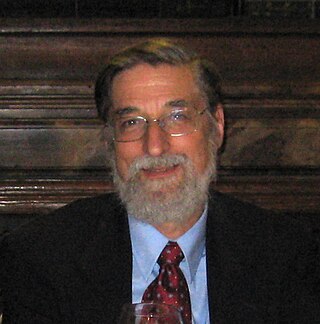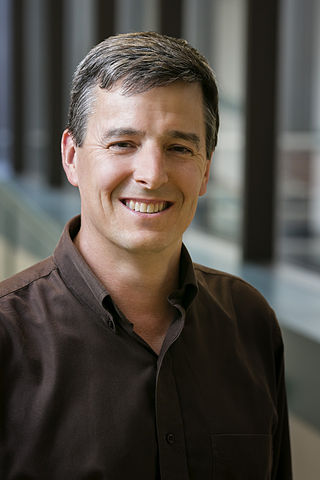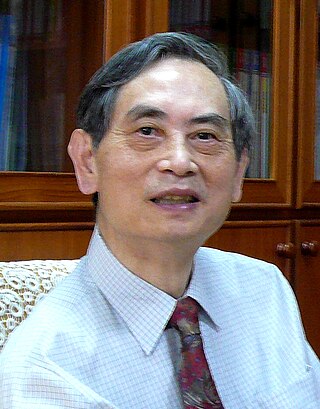
Soft matter or soft condensed matter is a type of matter that can be deformed or structurally altered by thermal or mechanical stress which is of similar magnitude to thermal fluctuations.

Bertrand I. Halperin is an American physicist, former holder of the Hollis Chair of Mathematicks and Natural Philosophy at the physics department of Harvard University. In 2006, he received the Wolf Prize in Physics for his various contribution to condensed matter physics, including work on KTHNY theory for two-dimensional melting.
Complex fluids are mixtures that have a coexistence between two phases: solid–liquid, solid–gas (granular), liquid–gas (foams) or liquid–liquid (emulsions). They exhibit unusual mechanical responses to applied stress or strain due to the geometrical constraints that the phase coexistence imposes. The mechanical response includes transitions between solid-like and fluid-like behavior as well as fluctuations. Their mechanical properties can be attributed to characteristics such as high disorder, caging, and clustering on multiple length scales.

John A. Rogers is a physical chemist and a materials scientist. He is currently the Louis Simpson and Kimberly Querrey Professor of Materials Science and Engineering, Biomedical Engineering, and Neurological Surgery at Northwestern University.
David Pines was a US physicist recognized for his work in quantum many-body systems in condensed matter and nuclear physics. With his advisor David Bohm, he contributed to the understanding of electron interactions in metals. Bohm and Pines introduced the plasmon, the quantum of electron density oscillations in metals. They pioneered the use of the random phase approximation. His work with John Bardeen on electron-phonon interactions led to the development of the BCS theory of superconductivity. Pines extended BCS theory to nuclear physics to explain stability of isotopes with even and odd numbers of nucleons. He also used the theory of superfluidity to explain the glitches in neutron stars.

Cherry A. Murray is an American academic who is professor of physics and the director of the Biosphere2 Institute at the University of Arizona at Tucson. She is the Benjamin Peirce Professor of Technology and Public Policy emerita at, and former dean of, the Harvard School of Engineering and Applied Sciences (SEAS).
Eric R. Weeks is an American physicist. He completed his B.Sc. at the University of Illinois at Urbana–Champaign in 1992. He obtained a Ph.D. in physics from the University of Texas at Austin in 1997, working under Harry Swinney, and later completed post-doctoral research with David Weitz and Arjun Yodh at Harvard University and the University of Pennsylvania. He is currently a full professor at Emory University in Atlanta, Georgia.

Sow-Hsin Chen, was a Hoklo Taiwanese physicist and Professor Emeritus at Massachusetts Institute of Technology (MIT). He was a recognized pioneer in the research of the dynamic properties of supercooled and interfacial water with the use of neutron scattering techniques. As an educator, he was recognized for his training of young scientists in the use of those same techniques. Regarding hydrogen storage, his research focused on the use of activated carbon to allow hydrogen to be stored at room temperature.

Michael Elmhirst Cates is a British physicist. He is the 19th Lucasian Professor of Mathematics at the University of Cambridge and has held this position since 1 July 2015. He was previously Professor of Natural Philosophy at the University of Edinburgh, and has held a Royal Society Research Professorship since 2007.

Stephen Ronald Quake is an American physicist, inventor, and entrepreneur.

Chinedum Osuji is the Eduardo D. Glandt Presidential Professor and the departmental chair of chemical and biomolecular engineering (CBE) at University of Pennsylvania. He is also a former Taekwondo Olympian and represented Trinidad and Tobago. His laboratory works on polymers and soft materials for functional application including liquid filtration. He is the associate editor of the journal Macromolecules.
David J. Pine is an American physicist who has made contributions in the field of soft matter physics, including studies on colloids, polymers, surfactant systems, and granular materials. He is professor of physics in the NYU College of Arts and Science and chair of the Department of Chemical and Biomolecular Engineering at the NYU Tandon School of Engineering.

Steve Granick is an American scientist and educator. In 2023 he joined the University of Massachusetts-Amherst as the Robert Barrett Endowed Chair of Polymer Science and Engineering, with joint appointment in the Chemistry, Physics, and Chemical Engineering Departments after serving as director of the Institute for Basic Science Center for Soft and Living Matter, an interdisciplinary blue-sky research center in Ulsan, South Korea that pursues basic science research. Until 2015 he was professor at the University of Illinois at Urbana-Champaign. He is a member of the American Academy of Arts and Sciences and the U.S. National Academy of Sciences.
Pierre Wiltzius is a physicist, the Executive Dean of the College of Letters and Science and Susan & Bruce Worster Dean of Science at the University of California, Santa Barbara and an Elected Fellow of the American Physical Society and of the American Association for the Advancement of Science.
Marjolein Dijkstra is a Dutch condensed matter physicist. She works as a professor in the Debye Institute for NanoMaterials Science at Utrecht University, and the Soft Condensed Matter group of the Department of Physics and Astronomy at Utrecht.
John C. Crocker is an American physicist and chemical engineer. He is a Professor of Chemical and Biomolecular Engineering at the University of Pennsylvania.
Jan Vincent Sengers is a Dutch–American physicist and a distinguished university professor emeritus at the Institute for Physical Science and Technology of University of Maryland. He is known for seminal contributions in critical and non-equilibrium phenomena in soft condensed matter.

Wim van Saarloos is a Dutch physicist, academic and researcher. He is a Professor of Theoretical Physics at Leiden University
Peter Fratzl is an Austrian physicist and director at the Max Planck Institute of Colloids and Interfaces in Potsdam.
Ivan I. Smalyukh is a physicist working in soft condensed matter physics, especially in the domain of liquid crystals. He is a professor in the Department of Physics at the University of Colorado at Boulder and director of the International Institute for Sustainability with Knotted Chiral Meta Matter with headquarters at Hiroshima University. Smalyukh was awarded the Presidential Early Career Award for Scientists and Engineers, among many other awards. He and his research group hold the Guinness record for achieving the highest visible-range optical transparency in a material.









